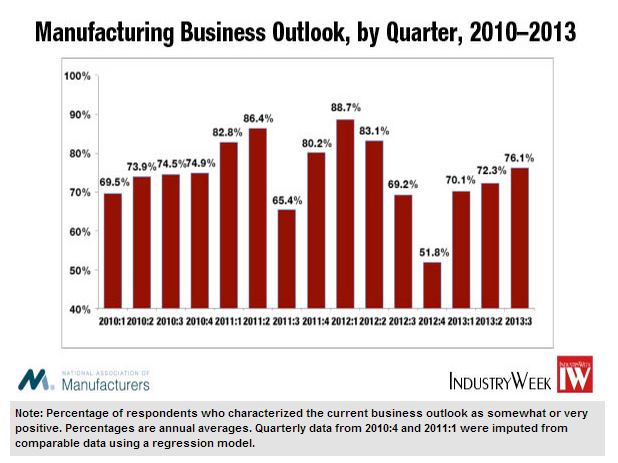 American manufacturing is making a resurgence. And with headlines like that, it is possible to see reshoring trends reflected more prominently in the data. The NAM/IndustryWeek 2013 Q3 Survey found manufacturing is “picking up steam.” And their data points to a 3.5% increase in manufacturing production, with the majority of employers not adding to payrolls. Many regional surveys backed up this analysis, with rebounds in the latest reports from ISM-Chicago and the Chicago and Dallas Federal Reserve Banks.
American manufacturing is making a resurgence. And with headlines like that, it is possible to see reshoring trends reflected more prominently in the data. The NAM/IndustryWeek 2013 Q3 Survey found manufacturing is “picking up steam.” And their data points to a 3.5% increase in manufacturing production, with the majority of employers not adding to payrolls. Many regional surveys backed up this analysis, with rebounds in the latest reports from ISM-Chicago and the Chicago and Dallas Federal Reserve Banks.
Manufacturing Resurgence Affects Symetrics, Industries LLC
Company: Symetrics, Industries LLC.
Industry: Aerospace and Defense
Region: National, International
Website: symetrics.com
Symetrics, Industries LLC. is a prime example of a manufacturing company affected by these trends.
Based in Florida, they specialize in design for the Department of Defense, Department of State, and prime contractors. They are an Epicor 9 success story because of the way they needed to improve productivity while reducing headcount. Updating their ERP system allowed them to streamline their operations using Epicor True SOA ™, an adaptable and collaborative business architecture.
“Every user on the Epicor system –from shop floor to top floor–now has the ability to see exactly where the product is in each stage of production,” said Peter Volkert, Director of Operations for Symetrics Industries, LLC. “Better information and more consistent information means fewer mistakes and less wasted time, money and material.”
Get Your Data in One Place with an ERP Upgrade
Symetrics Industries is an AS9100/ISO 9001-2000 registered company that designs, manufacturers and tests aerospace and defense (A&D) systems for both the U.S. government and other governments around the world. Its countermeasure systems recognize incoming rocket threats, such as shoulder-fired Stinger missiles, and direct them safely away. Description via Epicor.
“Our Epicor 9 system brings together information from all aspects of our business to provide ‘one version of the truth,’ via one set of data,” explained Volkert.


